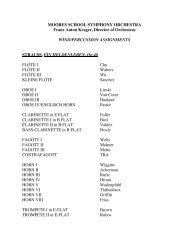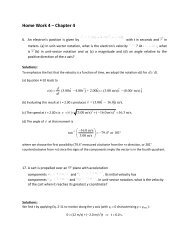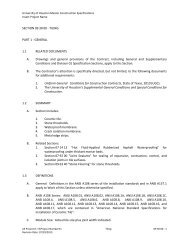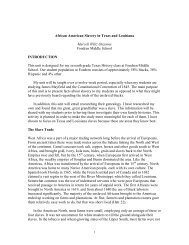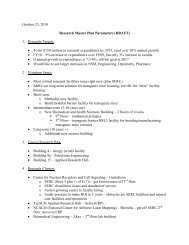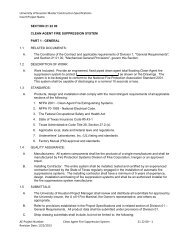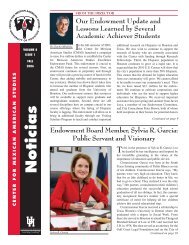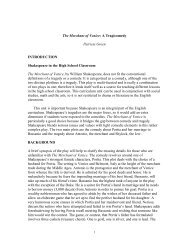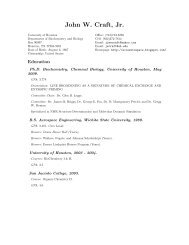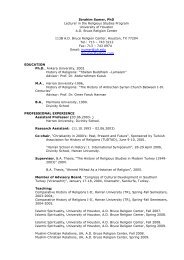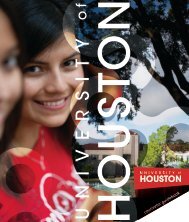Going Green: Biomimicry Francisca Eunice Gomez Rebullida ...
Going Green: Biomimicry Francisca Eunice Gomez Rebullida ...
Going Green: Biomimicry Francisca Eunice Gomez Rebullida ...
Create successful ePaper yourself
Turn your PDF publications into a flip-book with our unique Google optimized e-Paper software.
Material and Resources<br />
Create a PowerPoint presentation of the environment presenting the important topics for<br />
discussion. Provide students materials to create their own project showing an environment of their<br />
choice. Provide a copy of Michael Allaby’s The Environment. Provide computer access for the<br />
students. Prepare the vocabulary words and matching pictures to go with it.<br />
Procedures and Activities<br />
Divide the class into five groups. There are four students (second language learners with advance<br />
high students) in each group. Show the PowerPoint and engage the students in a discussion<br />
among themselves. Assign a speaker for each group to share their discussion. Teacher records<br />
students’ responses on chart paper. Introduce the key vocabulary words, such as environment,<br />
living organisms, Earth, core, atmosphere, and ozone layer. Ask volunteers to match the pictures<br />
with the key words. Brainstorm with the students on what they know about the Environment.<br />
Write their responses on a K-W-L (what do you Know; what do you Want to know; what did you<br />
Learn?) chart. Begin the lesson asking the students what they think the book is all about.<br />
Describe the cover page. Each group will give their response. Read with the class the<br />
environment, climates, and currents, plant life, etc. Provide teacher information and check for<br />
understanding (comprehension questions). Explain the reading and science connection to the<br />
students. The second reading will focus on the science concepts, such as environment; how the<br />
Sun, air, and water affect climate; weather and the different vegetation that grows in an<br />
environment; and how plants make their own food (photosynthesis) and its byproduct (oxygen).<br />
After the whole class session, assign a particular topic to a group and ask them to write a<br />
group summary of the science concept learned after reading the story. Students will write their<br />
responses in Science Journals. The next activity is role-playing. Ask each student to choose an<br />
object or a living organism. One student could role-play as Sun. He/she will explain to the class<br />
how Sun affects weather/ climate. Another student could be Leaf. He/she will explain how Leaf<br />
makes food (photosynthesis). Teachers provide “hats” for the students to use during role playing.<br />
For homework, assign students the task of creating a postcard of their environment and write<br />
good sentences to describe it. The postcard will be mailed to a friend or relative who lives in<br />
another place.<br />
Puzzle activity: Teachers will explain, for example, the nitrogen cycle. Give each group a<br />
puzzle of the different stages of the nitrogen cycle and let the students put the puzzle correctly.<br />
After that the students in groups of four will create a poster of the carbon-nitrogen cycle using the<br />
different stages. Allow three minutes for group presentation.<br />
Assessment<br />
Each student will create an environment of his or her choice in a foldable project. Create a rubric<br />
with the students. Then, choose two or three Texas Assessment of Knowledge and Skills (TAKS)<br />
related questions for the students to answer. Create a vocabulary foldable (teacher model) of the<br />
vocabulary words. Students will write the word, definition, give examples, draw the picture, and<br />
use the vocabulary word in a sentence. Create a teacher-made worksheet to test science concepts;<br />
for example, explain in your own words how plants make their own food; compare and contrast a<br />
food web from a food chain; illustrate and describe the lifecycle of a plant, lake, or animal.<br />
Lesson Plan Two: The Magic School Bus in the Rain Forest<br />
Objectives<br />
The students will be able to describe how living organisms modify their physical environment to<br />
meet their needs; identify patterns of change such as weather; and compare the adaptive<br />
characteristics of species that improve their ability to survive and reproduce in all ecosystems.<br />
<strong>Francisca</strong> <strong>Eunice</strong> <strong>Gomez</strong> <strong>Rebullida</strong> 77



